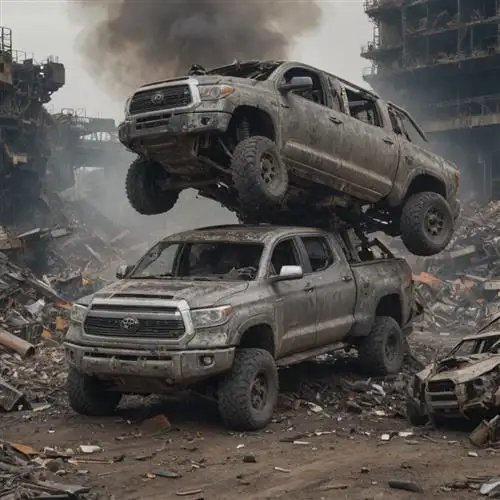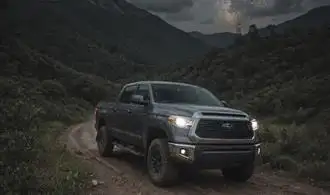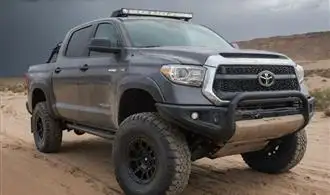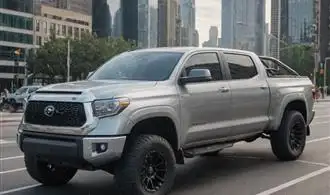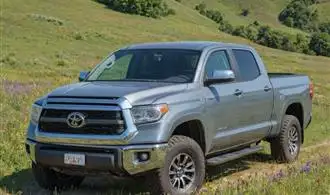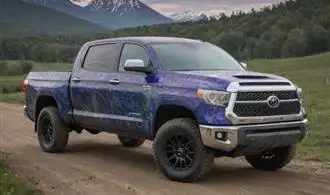
Underwhelming Performance
The Toyota Tundra, while a capable and durable truck, falls short when it comes to its powertrain performance. The engine options, while adequate for basic hauling and towing tasks, lack the punch and refinement found in competitors' offerings.
The base 4.6-liter V8 engine produces a modest 310 horsepower and 327 lb-ft of torque, which can feel underpowered when the truck is loaded or towing heavy loads. The optional 5.7-liter V8, while offering more power at 381 horsepower and 401 lb-ft of torque, still trails behind the V8 engines found in the Ford F-150, Chevrolet Silverado, and Ram 1500.
The Tundra's transmission, a 6-speed automatic, also feels dated compared to the 8- and 10-speed units found in rival trucks. The transmission can be slow to respond and can struggle to find the right gear, particularly when climbing hills or passing on the highway.
Fuel economy is another area where the Tundra falls short. The EPA-estimated fuel economy ratings for the Tundra, at 13 mpg city and 17 mpg highway for the 4.6-liter V8 and 13 mpg city and 18 mpg highway for the 5.7-liter V8, are on the lower end of the full-size truck segment.
Questionable Reliability
The Toyota Tundra has long been touted as a reliable and durable pickup truck, but recent reports have raised concerns about its questionable reliability. One of the most significant issues that Tundra owners have reported is the frequent occurrence of transmission problems. Many drivers have experienced sudden transmission failures, often requiring costly repairs or even complete replacements. This issue appears to be more prevalent in older models, but some newer Tundras have also experienced similar problems.
Another area of concern is the Tundra's engine performance. Some owners have reported issues with the engine stalling or experiencing power loss, particularly during high-demand situations such as towing or hauling heavy loads. These problems can not only be frustrating but also pose a safety risk, as sudden engine failure can lead to dangerous situations on the road.
The Tundra's electrical system has also been a source of concern for some owners. Reports of intermittent electrical issues, such as dashboard lights flickering or the audio system malfunctioning, have been common. These electrical gremlins can be difficult to diagnose and can lead to a range of other problems, including the potential for safety hazards.
Additionally, the Tundra has been known to experience issues with its suspension system. Some owners have reported premature wear and tear on the shocks and struts, leading to a rougher ride and increased maintenance costs. This can be particularly problematic for those who frequently use their Tundra for off-road adventures or heavy-duty hauling.
Uninspiring Design
The Toyota Tundra's design, often touted as a hallmark of its rugged capability, falls short in terms of inspiration and innovation. While the truck's bold, angular exterior may appeal to some, it lacks the contemporary flair and refined aesthetics that many modern truck buyers have come to expect. The Tundra's design language feels dated, with a boxy, utilitarian look that seems more at home in the past decade than the present.
One of the primary shortcomings of the Tundra's design is its lack of attention to detail. The truck's body panels appear to be assembled with a degree of haphazardness, with uneven gaps and inconsistent panel alignments that detract from the overall visual appeal. The use of cheap, low-quality materials in certain interior components further exacerbates the sense of a rushed, uninspired design.
Moreover, the Tundra's design fails to keep pace with the competition in terms of innovative features and technology integration. While Toyota has made efforts to modernize the truck's cabin, the overall user experience feels clunky and outdated, with an infotainment system that lags behind the industry standards in terms of responsiveness and intuitiveness.
The Tundra's exterior design also falls short in terms of aerodynamic efficiency, which can have a direct impact on fuel economy and overall driving dynamics. The truck's boxy shape and bulky proportions create significant wind resistance, leading to increased fuel consumption and a less refined driving experience.
Subpar Technology Features
When it comes to the Toyota Tundra, the technology features can be a mixed bag. While the truck boasts impressive capabilities in terms of power and towing, its tech offerings often fall short of the competition. One of the most glaring issues is the subpar infotainment system, which can be clunky and outdated compared to the seamless experiences found in other modern trucks.
The Tundra's base infotainment system is a 7-inch touchscreen that, while functional, lacks the responsiveness and intuitive design found in many rival models. The graphics are dated, and the menu layout can be confusing to navigate. Even the available 8-inch upgrade does little to address these shortcomings, leaving users longing for a more polished and user-friendly experience.
Another area of concern is the Tundra's lack of advanced connectivity features. While it does offer Apple CarPlay and Android Auto integration, the implementation can be finicky, with occasional connectivity issues and lag. The absence of wireless versions of these features is also a noticeable omission, especially in a truck that aims to cater to modern technology-savvy consumers.
Furthermore, the Tundra's suite of driver assistance technologies, often referred to as "Toyota Safety Sense," is not as comprehensive as what is offered by competitors. While it does include essential features like forward collision warning and lane departure alert, more advanced functions like adaptive cruise control and lane-keeping assist are either unavailable or only offered as optional extras, further limiting the Tundra's technological prowess.
Disappointing Fuel Economy
Fuel economy is a significant concern for many Toyota Tundra owners, and for a good reason. Despite its rugged capabilities, the Tundra's fuel efficiency lags behind its competitors, leaving a sour taste in the mouths of those seeking a fuel-efficient full-size pickup. The Tundra's thirsty V8 engine, combined with its hefty curb weight, results in lackluster gas mileage, often falling short of the promised EPA estimates.
In the city, the Tundra struggles to achieve even 15 miles per gallon, a far cry from the double-digit figures claimed on the window sticker. On the highway, the truck's fuel efficiency improves slightly, but it still falls short of the competition, often hovering around the 18-20 mpg range. This can be a significant drawback for those who rely on their Tundra for daily commuting or frequent long-distance hauling.
The culprit behind the Tundra's thirst for fuel is its aging powertrain. While the 5.7-liter V8 engine provides ample power, it lacks the advanced technologies and efficiency-focused engineering found in newer engine designs. This, coupled with the truck's substantial dimensions and weight, creates a perfect storm of poor fuel economy, leaving Tundra owners to grapple with the persistent need to refuel more often than they'd like.


